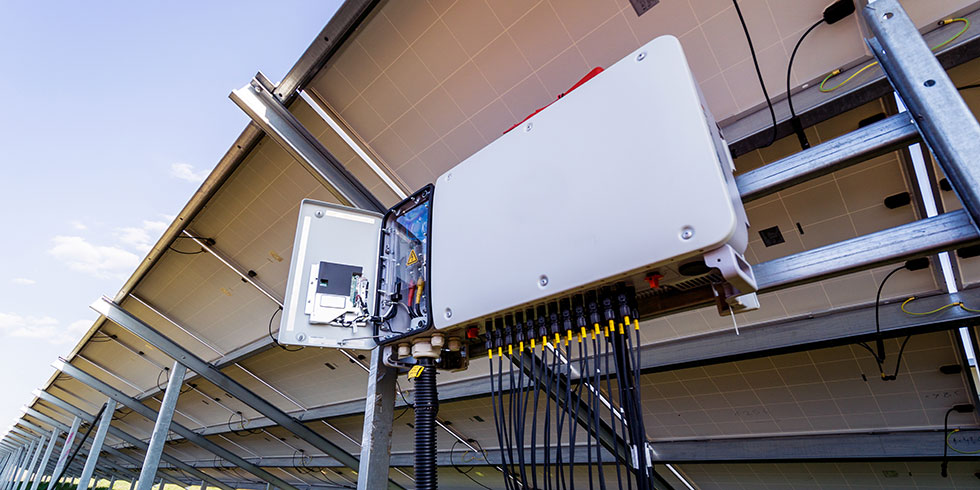When it comes to harnessing solar energy, one critical component of a solar system is the inverter. Inverters are responsible for converting the direct current (DC) electricity generated by solar panels into alternating current (AC) electricity for your home. There are two common types of inverters used in solar installations: string inverters and micro-inverters.
In this blog, we will explain the difference and benefits of string inverters vs. micro-inverters to help you make an informed decision for your solar energy system.
Understanding String Inverters
String inverters work by connecting multiple solar panels in a series, forming a “string” of panels. These panels feed DC electricity into the string inverter, which converts it into AC electricity for your home.
Advantages of String Inverters
Cost-Effective: String inverters are generally more affordable upfront compared to micro-inverters, making them an attractive choice for budget-conscious consumers.
Proven Technology: String inverters have a track record of reliability as they have been used in solar installations for a long time.
Easy Maintenance: Since all the panels are connected to a single inverter, maintenance is simplified, and any issues can be diagnosed easily.
Drawbacks of String Inverters
Performance Impact: If one panel in a string is shaded or malfunctioning, it can affect the entire string’s performance.
Design Limitations: String inverters are less flexible in terms of system design, making them less suitable for complex roof layouts.
Limited Monitoring: Monitoring individual panel performance is not possible with string inverters.
Warranty: String inverters feature 12 years of warranty.. With solar system lifespans being 30+ years, it’s likely that a solar owner will need to replace their inverter during the life of the system.
Exploring Micro-Inverters
Unlike string inverters, micro-inverters are attached to each individual solar panel (or every two panels), allowing for more granular control of the system.
Benefits of Micro-Inverters
Individual Panel Optimization: Micro-inverters are installed on each solar panel, allowing each panel to operate independently. This means that shading or issues with one panel do not affect the others, leading to increased overall system efficiency.
Detailed Monitoring: Micro-inverters come with built-in monitoring systems that allow you to track the performance of each panel in real time, enabling easier maintenance and issue detection.
Scalability: Micro-inverters make it easier to expand your solar system by adding more panels as needed.
Flexible Design: Micro-inverters offer more flexibility in system design, making them ideal for installations with irregular roof shapes or varying sun exposure.
Warranty: Our chosen micro-inverter brands feature 25 year standard warranty, eliminating the possibility that a customer will have to pay for replacement parts on their solar system in the first 25 years.
Drawbacks of Micro-Inverters
Higher Cost: Micro-inverters tend to be more expensive than string inverters.
Maintenance Complexity: While they offer panel-level monitoring, the maintenance and troubleshooting can be more intricate due to the fact that replacements happen on the roof, unlike string inverters, which are at ground level.
Choosing the Right Inverter for Your System
The choice between string and micro-inverters depends on your specific needs and preferences. Here are some considerations to help you decide:
Budget: A string inverter may be suitable if you are looking for a more cost-effective option upfront and have a simple roof layout. However, consider the long-term benefits of micro-inverters in terms of performance and monitoring.
Panel Configuration: If your solar panels are in an area with potential shading issues or varying orientations, micro-inverters mitigate these problems.
Monitoring: If you want detailed insights into your solar system’s performance, micro-inverters with panel-level monitoring give more useful data.
Expansion Plans: If you plan to expand your solar array in the future, micro-inverters provide greater flexibility.
System Size: For small installations, the cost difference between string and micro-inverters may not be significant. However, for larger systems, it’s important to weigh the initial cost against long-term performance benefits.
Conclusion
In the debate of string inverters vs. micro-inverters, there is no one-size-fits-all answer. It’s important to consider the pros and cons of each option before making a decision. Ultimately, the choice you make will depend on your unique needs and personal preferences. It’s essential to consult with a solar professional who can assess your situation and provide tailored recommendations.
Do you want to see what you can be saving with solar?
About Astra Solar
Astra Solar exists because we believe our greatest resource, the sun, is under-utilized. Driven by our vision to lead Manitoba in its pursuit of renewable energy for a stronger, healthier and more sustainable community, Astra Solar delivers solutions that make solar energy and vehicle charging infrastructure affordable and accessible to all Manitobans.

